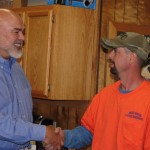(Editor’s note: The following is from a press release from the Idyllwild Forest Health Project.)
On Wednesday, Oct. 10, the Idyllwild Forest Health Project will host “From Ashes: Lessons from the Cranston Fire,” a fire ecology learning event at Idyllwild Arts Academy. The event will begin with a tour of the burned area at the edge of campus guided by Idyllwild Fire Chief Patrick Reitz and fire ecology professor Dr. Richard Minnich of the University of California, Riverside.
Participants will see first-hand how reduction of forest and chaparral fuels was crucial to saving Idyllwild from catastrophic wildfire.
Gerald Clarke of the Cahuilla people and William Pink of the Luiseño/Cupeño people will discuss forest management as practiced by native Californians for millennia before the arrival of Europeans. Mark Yardas and Mara Schoner of IFHP will facilitate the event.
According to fire ecologists, the local forests historically consisted of 40 to 80 large trees per acre. The late-19th and early 20th centuries saw logging and clear-cutting throughout the West followed by intense fire suppression, resulting in the uninterrupted growth of underbrush and smaller trees. In a matter of decades, the landscape transformed from more open forests through which one could easily drive a carriage, to thick, cluttered masses of smaller trees mixed with chaparral from lower elevations. Today, it’s not uncommon to see 1,200 to 2,000 trees per acre across the state.
All these small trees compete with each other for water, which is scarce in our current drought conditions. Many trees die from the lack of water and increased susceptibility to pests such as the bark beetle. Because of the high forest and chaparral fuel loads throughout the mountains, high-intensity “megafires” pose a constant threat.
Native Californians traditionally used fire to reduce fuel loads, aid in hunting and enhance the production of plant food, especially acorns, a major staple of their diet. Fewer trees required less water, improving the overall health of the land.
Scientists are discovering that Traditional Ecological Knowledge, or TEK, has much to offer to the ongoing dialogue about caring for the land.
In Wednesday’s event, speakers will talk about the history of our forest and its relationship to fire. They also will explore ways in which a more robust fuels-reduction program can be both ecologically sound and financially self-supporting.
“Living in this forest is a privilege,” said IFHP founder Yardas. “We have to better understand how to care for it — for our own safety, for the health of the land and for the benefit of future generations.”
The event begins at 5:30 p.m. from Stephens Recital Hall with a tour of the burn area at the edge of campus. A reception begins at 6:30 p.m. followed by the presentations from 7 to 9 p.m. From 9 to 10 p.m., guests are welcome to stay to learn more.










